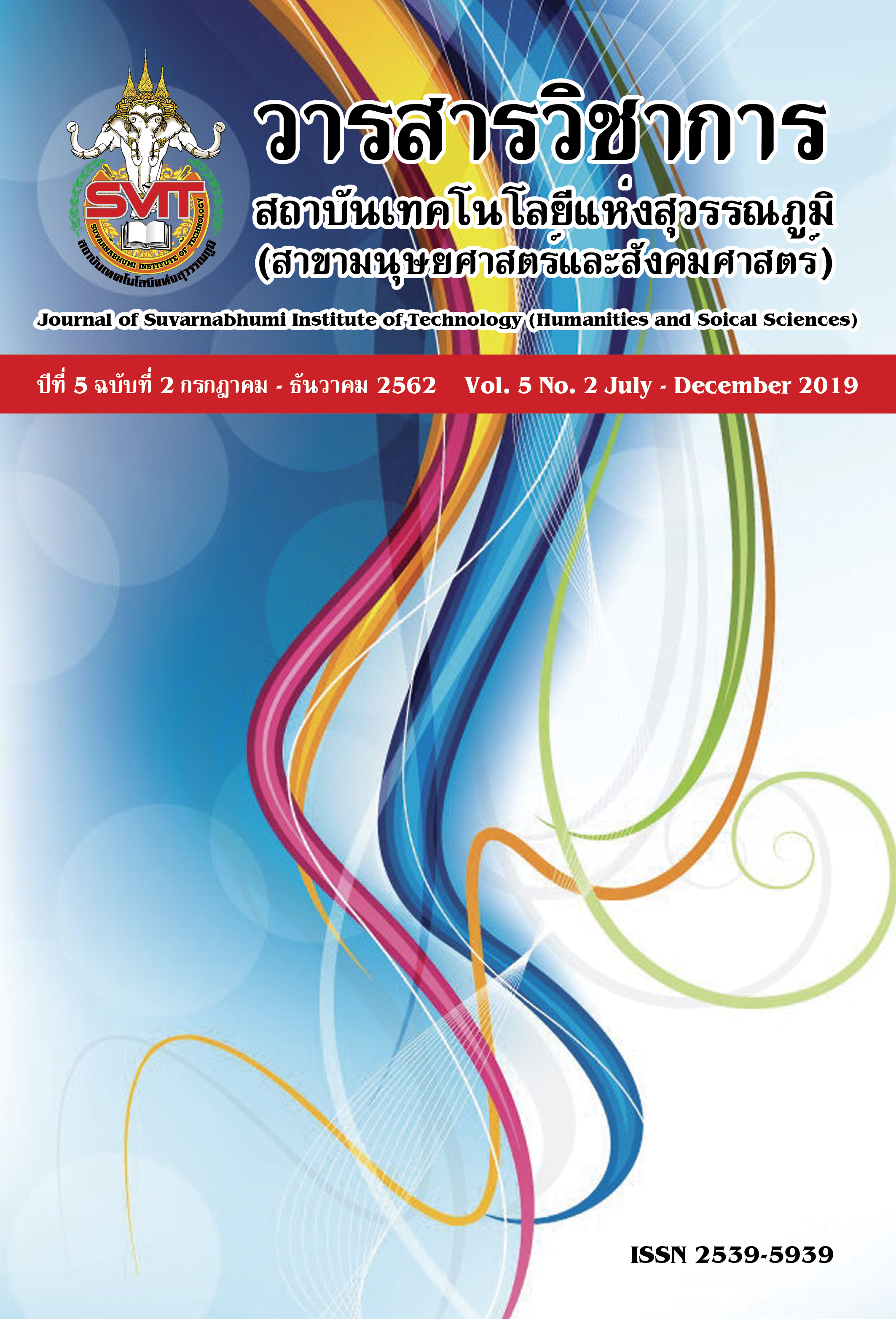THE LEADERSHIP MODEL FOR THE MIDDLE-LEVEL EXECUTIVES IN THE SECURITY BUSINESS SECTOR IN THE 21st CENTURY
Keywords:
leadership, middle-level executives, the security business sectorAbstract
In this dissertation, the researcher studies (1) the conditions and problems in the use of leadership for middle-level executives in the security business sector; constructs (2) a 21st century leadership model for these executives; and then (3) evaluates the model. The research investigation was conducted in three steps taken seriatim as follows: In Step One, the researcher studied the conditions and problems in the use of leadership for middle-level executives in the security business sector by means of conducting semi-structured interviews with twenty-five key informants. In Step Two, the researcher constructed a leadership model for the middle-level executives. An open-ended questionnaire and a five-rating scale questionnaire eliciting germane data appertaining to the use of leadership for the middle-level executives were used. The Delphi method was employed for three rounds carried out by eighteen experts. The data collected were analyzed through determining the median (Mdn) and establishing the interquartile range (IQR) within which the data fell. In Step Three: evaluation by seven experts established whether the leadership model for the middle-level executives showed appropriateness.
Findings are as follows: (1) In regard to the conditions and problems in the use of leadership by the middle-level executives under investigation, key informants expressed the following opinions: Planning and communication pertaining to work performance must be in accordance with a clear delineation of the company. Orders are not clearly stated. Authority to make decisions is not assigned in writing. There are no reports summarizing work performance in response to variegated problems and methods recorded by a central information agency which in turn would notify personnel at all levels. (2) The leadership model constructed by the researcher was viewed by examining exports as a transactional leadership and transformational leadership model. The administration process was to consist of four steps: planning, management, ordering, and control. (3) The experts’ opinions on the leadership model for middle-level executives in the security business sector as a model of transactional leadership and transformational leadership was appropriate at the highest level.
References
กฤษดา ตั้งชัยศักดิ์ และณรัฐ วัฒนาพานิช . (2560). การจัดการและพฤติกรรมองค์การ. กรุงเทพฯ : แดเน็กซ์อินเตอร์คอร์เปอเรชั่น.
กิตติพงศ์ กิตยารักษ์. (2550). การพัฒนาระบบยุติธรรมชุมชนในสังคมไทย. กรุงเทพมหานคร : สำนักงานกองทุนสนับสนุนการวิจัย (สกว).
ข้อบังคับสภาขับเคลื่อนการปฏิรูปประเทศ พ.ศ. 2558 (3 พฤศจิกายน 2558) ราชกิจจานุเบกษา, เล่ม 132 ตอนพิเศษ 279 ง, น. 21-41.
ภานุพงศ์ สุนทรา. (2550). หลักการทรงงาน 9 ประการ. ค้นเมื่อ 3 กุมภาพันธ์ 2561, จาก https://www.skareal.org/smms/pic/panu3.doc
ธุรกิจรักษาความปลอดภัย: ธุรกิจที่ยังเติบโตต่อเนื่อง. (2553). ค้นเมื่อ 20 กุมภาพันธ์ 2561, จาก https://positioningmag.com/52192
บุญช่วย โชติวโสและสุนทร สายคำ. (2560). ภาวะผู้นำของผู้บริหารในมุมมองของผู้ใต้บังคับบัญชา. วารสารสถาบันวิจัยภิมลธรรม, 4(2), 15-28.
ยุทธพงค์ ทิพย์วงศ์. (2557). ธุรกิจรักษาความปลอดภัย แข่งดุ ชิงเค้กหมื่นล้าน!!!.ค้นเมื่อ 20 กุมภาพันธ์ 2561, จาก https://pantip.com/topic/32649418
วิจารณ์ พานิช. (2555). วิถีสร้างการเรียนรู้เพื่อศิษย์ในศตวรรษที่ 21. กรุงเทพมหานคร: มูลนิธิสดศรีสฤษดิ์วงศ์.
อาภรณ์ แก้วสลับศรี. (2552). ระบบงบประมาณ จากแบบแสดงรายการ สู่แบบมุ่งเน้นผลงาน. สงขลา: มหาวิทยาลัยทักษิณ, กองแผนงาน.
Burns, J. M. (1978). Leadership. New York: Harper and Row.
Daft, R. L. (2012). New era of management. South-Western: Cengage Learning.
Fayol, H. (1949). General and industrial management. London: Pitman.
Fayol, H. (1964). General and industrial management. London : Pittman and Sons.
Hellriegel, D., Jackson, S. E., & Slocum, J. W. (2008). Management:A competency-based approach (11th ed.). Mason, OH: Thomson/South-Western.
House, R. J. (1977). A 1976 theory of charismatic leadership. In J. G. Hunt & L. L. Larson (Eds.), Leadership: The Cutting Edge. Carbondale, IL: Southern Illinois.
Hurtz, G. M., & Kevin, J. W. (2009). Attitudinal and motivation antecedents of participation in voluntary employee development activities. Journal of Apply Psychology, 94(3), 635-653.
Kotter, J. P. (1990). A force for change: How leadership differs from management. New York: The Free Press.
Kotter, J. P. (1998). Leading change: Why transformation efforts fail. Boston: Harvard Business School Press.
Robbins, S. P. & Judge, T. A. (2011). Organizational behavior (14th ed.). Upper Saddle River, NJ: Pearson Education.
Robbins, Stephen P.; Coultre (2016), Four Functions of Management. (p. 42 ), Mary, Management 13th Edition.
Weebly.com. (2014). 21st century leadership skills. Retrieved May 25, 2013, from https://www.traceyhumel.weebly.com/21st- century-Leadership-skills.html
Yukl, Gary & Fleet D. Van David. (1992). “Theory and research on leadership in
organizations ,in handbook of industrial and organization psychology” California :
Consulting Psychologists.
Downloads
Published
Issue
Section
License
บทความที่ได้รับการตีพิมพ์เป็นลิขสิทธิ์ของวารสารวิชาการ สถาบันเทคโนโลยีแห่งสุวรรณภูมิ
ข้อความที่ปรากฏในบทความแต่ละเรื่องในวารสารวิชาการเล่มนี้เป็นความคิดเห็นส่วนตัวของผู้เขียนแต่ละท่านไม่เกี่ยวข้องกับสถาบันเทคโนโลยีแห่งสุวรรณภูมิ และคณาจารย์ท่านอื่นๆในสถาบันฯ แต่อย่างใด ความรับผิดชอบองค์ประกอบทั้งหมดของบทความแต่ละเรื่องเป็นของผู้เขียนแต่ละท่าน หากมีความผิดพลาดใดๆ ผู้เขียนแต่ละท่านจะรับผิดชอบบทความของตนเองแต่ผู้เดียว





